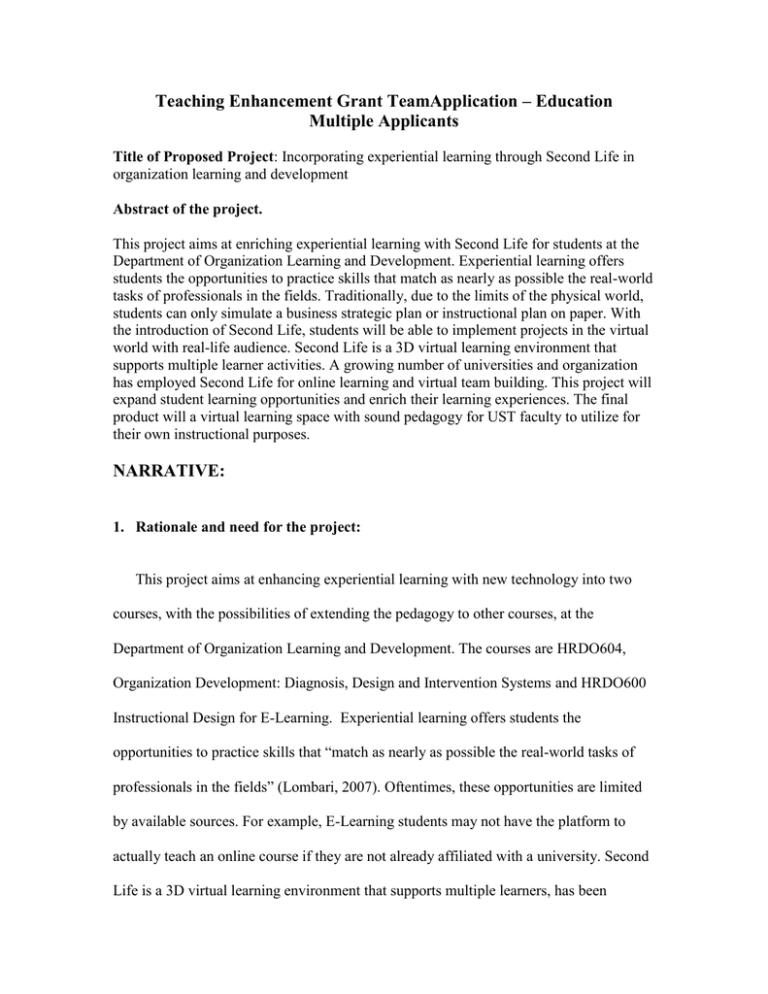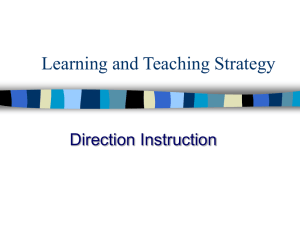Example of a Successful Proposal: Organization Learning and Development (team)
advertisement

Teaching Enhancement Grant TeamApplication – Education Multiple Applicants Title of Proposed Project: Incorporating experiential learning through Second Life in organization learning and development Abstract of the project. This project aims at enriching experiential learning with Second Life for students at the Department of Organization Learning and Development. Experiential learning offers students the opportunities to practice skills that match as nearly as possible the real-world tasks of professionals in the fields. Traditionally, due to the limits of the physical world, students can only simulate a business strategic plan or instructional plan on paper. With the introduction of Second Life, students will be able to implement projects in the virtual world with real-life audience. Second Life is a 3D virtual learning environment that supports multiple learner activities. A growing number of universities and organization has employed Second Life for online learning and virtual team building. This project will expand student learning opportunities and enrich their learning experiences. The final product will a virtual learning space with sound pedagogy for UST faculty to utilize for their own instructional purposes. NARRATIVE: 1. Rationale and need for the project: This project aims at enhancing experiential learning with new technology into two courses, with the possibilities of extending the pedagogy to other courses, at the Department of Organization Learning and Development. The courses are HRDO604, Organization Development: Diagnosis, Design and Intervention Systems and HRDO600 Instructional Design for E-Learning. Experiential learning offers students the opportunities to practice skills that “match as nearly as possible the real-world tasks of professionals in the fields” (Lombari, 2007). Oftentimes, these opportunities are limited by available sources. For example, E-Learning students may not have the platform to actually teach an online course if they are not already affiliated with a university. Second Life is a 3D virtual learning environment that supports multiple learners, has been employed by many corporations and universities for learning and training, is a low barrier-to-entry for content creation, is programmable, and provides an abundant reusable instructional content (Mason, 2007). In the last few years, a rapidly growing number of business and universities have established presence in Second Life. People enter the virtual worlds in Second Life via an avatar which is their representation in the virtual learning space. The avatars can walk, talk, and move around the same way that they would move in real world. By using Second Life as a platform for experiential learning, this project team can engage students in simulation, collaboration, problem-solving, roleplay with real world audience. Traditionally, these courses require students to complete a diagnostic or design plan to address issues faced in organizations or E-Learning environments. The students do not really have to carry out these plans due to a lack of clients and the limits of the physical world. Through this project, the students would have an opportunity to experiment with a strategic solution or instructional plan in Second Life, where they will continually evaluate and revise projects throughout the course. Second Life provides an excellent expansion of problems that students are able to address. Students will be able to create an online classroom with the virtual artifacts that resemble the settings of a classroom or a consulting firm. Students will be able to go beyond the limits of the physical world and meet with clients to carry out their business plans and receive direct feedback from peer or clients. The project team believe that the expanded learning opportunity will lead to greater learning outcomes than were previously possible. 2. Goals and objectives: This grant will provide the necessary funding for the project team to receive professional development at conferences and develop a Second Life virtual learning space that is based on experiential learning model. Students will be able to develop authentic projects with real-life clients. The following goals and objectives outline this initiative. Goal A: Establish a presence in Second Life for the Department of Organization Learning and Development Objective A.1: Consult with IRT to seek sponsorship in funding and technology support to secure a land in Second Life Objective A.2: Study virtual learning environments by other universities in similar disciplines to determine the best scenario for the project Goal B: Apply new instructional strategies and artifacts for virtual learning space Objective B.1: Research case studies and best practices that have utilized Second Life for experiential learning through the Internet, library, academic listserv, and professional conferences Objective B.2: Obtain objects in Second Life that can be used for the virtual organization learning Objective B.3: Acquire the skills necessary to build instructional objects that simulate an online classroom or a business meeting Goal C: Create instructional materials and activities to be implemented in classes Objective C.1: Write instructional scenarios to provide examples on how to use of simulation, role-play, and problem-solving in virtual worlds Objective C.2: Create new activities to engage students in experiential learning with Second Life 3. Activities: Phase 1 Virtual Classroom Preparations (goal A): The project team will buy or lease land in Second Life to set up a professional learning space for students to construct their own cubicles for the development of business strategies. Since this might be the first example of a graduate program utilizing Second Life for classroom instruction, we have consulted with IRT on the possible funding or technical support. However, Second Life support does not fall into the norms of the IRT services. Our initial inquiry with IRT has not received a firm answer on whether we will receive any support. The project team has sufficient technical skills to move on with the project although we would prefer collaborating with IRT. This project funding will help with the implementation of a virtual learning space in due time without delay. The project team will also investigate the existing the settings of virtual classrooms or training rooms that have been established by other organizations or universities in order to come up with the best design of our classroom. Phase 2 New pedagogy development (goal B): This would be our first experience in employing the principles of experiential learning with Second Life in our teaching although both team members have utilized experiential learning in traditional face-to-face teaching. We will actively participate in Second Life listserv, wiki, blogs, webinars, and professional conferences. We have identified two conferences that focus on the best educational practices of Second Life. The first is the annual conference of “Virtual Words Best Practices in Education” to be held in Second Life (virtual participation) in March 2009 and the second conference is the “Second Life Educational Community Convention” to be held in San Francisco in August 2009. We believe that both conferences will provide a wealth of most recent research and best practices in Second Life. Phase 3 Classroom activities creation (goal C): The project team envisions that the students will act as organization development consultants or E-Learning designers to provide solutions to clients. We will adopt Kolb’s (1984) four-stage experiential learning model (experience-reflection-abstraction-experimentation) to design the learning activities. The following is a description of possible classroom or online activities. . ELearning students will create a course module and run the prototype of the training module in Second Life, where they will continually evaluate and revise projects throughout the course. Organization development students will facilitate a learning module focusing on a variety of “types of interventions” using Second Life. At the beginning of the course, students will complete assigned readings and hands-on practice to acquaint them with the major instructional design concepts. They will also receive orientation to Second Life. Students will start with a scavenger hunt in Second Life to become familiar with navigation and learn some places of interests in Second Life. Each team will receive a starter kit on how to construct a meeting place and conduct consultation sessions with clients. After the experimental component, students will be assessed with both authentic and traditional assessment tools. They will reflect on the learning and designing processes through online journals. They will also receive peer evaluation on the authenticity of the projects. 4. Evaluation: Objectives Evaluation Objective A.1 Work with IRT Objective A.2 Virtual learning space examples Responses from IRT consultants Compile a report in the project blog/wiki on examples of virtual learning space in Second Life by other universities and organizations Objective B.1 Research best Compile a report on the best practices and lesson practices plans Objective B.2 Collect Second Life Set up an inventory of objects in Second Life for objects educators and students to use Objective B.3 Advance skills Complete the classroom setup and invite colleagues to provide feedback Objective C.1 Create instructional Provide various instructional scenarios in project scenarios blog/wiki and ask colleagues or E-Learning Center consultants for feedback Objective C.2 Create new Provide activity handouts in project blog/wiki and activities ask colleagues or E-Learning Center consultants for feedback 5. Dissemination: A blog and wiki will be created to share educational resources, recent research, bibliography, instructional scenarios, and handouts with the UST and educational community. This blog/wiki will include information and access to the Second Life learning space for all educators who would like to utilize the materials for their own classroom instruction. We plan to implement the new pedagogy in spring 2010. We would propose a presentation with the IRT E-Learning Center to share our experience and the results.

